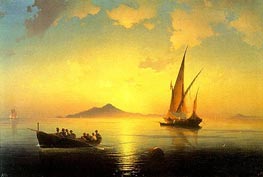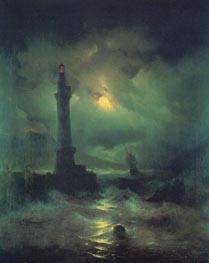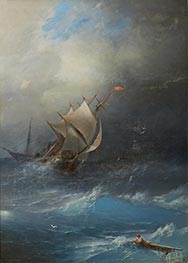The Battle in the Straits of Chios, 24 June 1770, 1848 Ivan Konstantinovich Aivazovsky (1817-1900)
Location: I. K. Aivazovsky Museum Feodosia UkraineOriginal Size: 220 x 190 cm
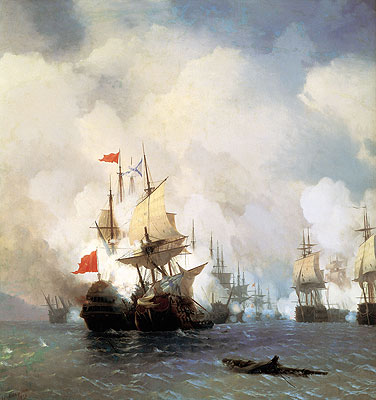
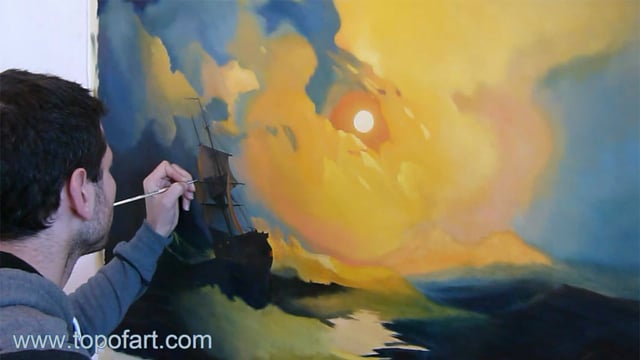
Recreating Aivazovsky: A Video Journey into Museum-Quality Reproductions by TOPofART
Video showcasing the process of hand-painting a Aivazovsky masterpiece with the utmost precision and care for detail.
Oil Painting Reproduction
If you want a different size than the offered
Description
Painted by European Аrtists with Academic Education
Museum Quality
+ 4 cm (1.6") Margins for Stretching
Creation Time: 8-9 Weeks
Creation Process
We create our paintings with museum quality and covering the highest academic standards. Once we get your order, it will be entirely hand-painted with oil on canvas. All the materials we use are the highest level, being totally artist graded painting materials and linen canvas.
We will add 1.6" (4 cm) additional blank canvas all over the painting for stretching.
High quality and detailing in every inch are time consuming. The reproduction of Ivan Konstantinovich Aivazovsky also needs time to dry in order to be completely ready for shipping, as this is crucial to not be damaged during transportation.
Based on the size, level of detail and complexity we need 8-9 weeks to complete the process.
In case the delivery date needs to be extended in time, or we are overloaded with requests, there will be an email sent to you sharing the new timelines of production and delivery.
TOPofART wants to remind you to keep patient, in order to get you the highest quality, being our mission to fulfill your expectations.
We not stretch and frame our oil paintings due to several reasons:
Painting reproduction is a high quality expensive product, which we cannot risk to damage by sending it being stretched.
Also, there are postal restrictions, regarding the size of the shipment.
Additionally, due to the dimensions of the stretched canvas, the shipment price may exceed the price of the product itself.
You can stretch and frame your painting in your local frame-shop.
Delivery
Once the painting The Battle in the Straits of Chios, 24 June 1770 is ready and dry, it will be shipped to your delivery address. The canvas will be rolled-up in a secure postal tube.
We offer free shipping as well as paid express transportation services.
After adding your artwork to the shopping cart, you will be able to check the delivery price using the Estimate Shipping and Tax tool.
Museum Quality
The paintings we create are only of museum quality. Our academy graduated artists will never allow a compromise in the quality and detail of the ordered painting. TOPofART do not work, and will never allow ourselves to work with low quality studios from the Far East. We are based in Europe, and quality is our highest priority.
Additional Information
The Russo-Turkish War had begun in 1768, and Russia sent several squadrons from the Baltic Sea to the Mediterranean Sea to draw Turkish attention away from their Black Sea fleet, then only 6 battleships strong. Two Russian squadrons, commanded by Admiral Grigory Spiridov and Rear Admiral John Elphinston[1], a British advisor, combined under the overall command of Count Alexey Orlov, Commander-in-Chief of the Russian Fleet and went to look for the Turkish fleet.
On 5 July 1770 they came across it anchored in line just north of Cesme Bay, western Turkey. Details of the Turkish fleet are uncertain but it included 14-16 battleships including Real Mustafa of 84 guns, Rodos of 60 guns and a 100-gun flagship. In addition there were perhaps 6 frigates, 6 xebecs, 13 galleys and 32 small craft, with about 1300 guns in total. 10 of the battleships, of 70-100 guns, were in the Turkish main line with a further 6 or so battleships in the 2nd, arranged so that they could fire through the gaps in the first line. Behind that were the frigates, xebecs etc. The fleet was commanded by Kapudan Pasha Husameddin, in the 4th ship from the front (north end) of the line, with Hasan Pasha in the first ship, Real Mustafa, and Cafer Bey in the 7th. Two further battleships, probably small, had left this fleet for Mytilene the previous evening.
After organizing a plan of attack, the Russian battle line (see Table 1) sailed towards the south end of the Turkish line and then turned north, coming alongside the Turks, with the tail end coming into action last (Elphinston had wanted to approach the northern end first, then follow the wind along the Turkish line, attacking their ships one by one - the method used by Nelson at the Battle of the Nile in 1798). The Turks opened fire at about 11.45am, followed by the Russians slightly later. Three of the Russian battleships had trouble staying in position; Evropa turned around and came back behind Rostislav, Trech Svyatitelai circled the 2nd Turkish vessel before coming back into the Russian line, being attacked in error by Trech Ierarchov as she did so, and Sv. Ianuarii turned around before coming back into the line.
Spiridov, in Sv. Evstafii, had a close-range battle with Hasan Pasha in Real Mustafa, before the latter was suddenly seen to be on fire. Her mainmast came down and landed on Sv. Evstafiis deck, causing the Russian ship to immediately blow up. Shortly later Real Mustafa blew up as well.
According to Elphinston, who claimed the Russians were almost useless, Spiridov and Count Feodor Orlov (brother of the commander), had left Sv. Evstafii before the fighting became close-range. Spiridov ended up on Trech Svyatitelai. Sv. Evstafii's captain, Kruse, survived too. At about 2pm the fighting ended, as the Turks cut their cables and moved south into the bay, forming themselves into a defensive line of 8 battleships, a 2nd line, and the rest beyond.
During 6 July the Russians bombarded the Turkish ships and land positions and at about 12:30am on the morning of 7 July Orlov sent Samuel Greig (who transferred to Rostislav) to attack with Evropa, Rostislav and Ne tron menya forming a south-north line facing the Turks, and with Saratov in reserve, Nadezhda attacking the batteries at the eastern side of the bay entrance, Afrika attacking the batteries on the western side, and Grom near Afrika. At about 1:30 am or earlier (note: times were about 90 minutes earlier according to Elphinston), fire from Grom and/or Ne tron menya caused 1 Turkish battleship to blow up after her main topsail caught fire, and the fire quickly spread to other battleships. By 2am 2 Turkish battleships had blown up and more were on fire, and Greig sent in 3 fireships (the 4th, seeing the danger, stayed out), which contributed in a small way to the burning of almost the entire Turkish fleet. At about 4am boats were sent in to save 2 battleships which were not burning, but 1 of these caught fire while it was being towed. The other, Rodos 60, survived and was captured along with 5 galleys (or galliots?). Fighting ended at about 8am. Russian casualties on the 5 July were 14 killed, plus 636 killed in Sv. Evstafii, and about 30 wounded, and on the 7 July 11 killed. Turkish casualties were much higher. Husameddin, Hasan Pasha and Cafer Bey survived. Husameddin was removed from his position and it was given to Cafer Bey. This was the only significant fleet battle during the Russo-Turkish War.
Significance
The battle of Chesma was fought on the same day as the land Battle of Larga. It was the greatest naval defeat suffered by Turkey since the Battle of Lepanto (1571). This battle inspired great confidence in the Russian fleet and allowed the Russians to control the Aegean Sea for some time. The defeat of the Turkish fleet also sped up rebellions by minority groups in the Ottoman Empire, especially the Orthodox Christian nations in the Balkan peninsula, who helped the Russian army in defeating Turkey.
Catherine the Great commissioned four monuments to commemorate the victory: Chesma Palace and Church of Saint John at Chesme Palace in St Petersburg (1774-77), Chesma Obelisk in Gatchina (1775), and Chesma Column in Tsarskoe Selo (1778).
